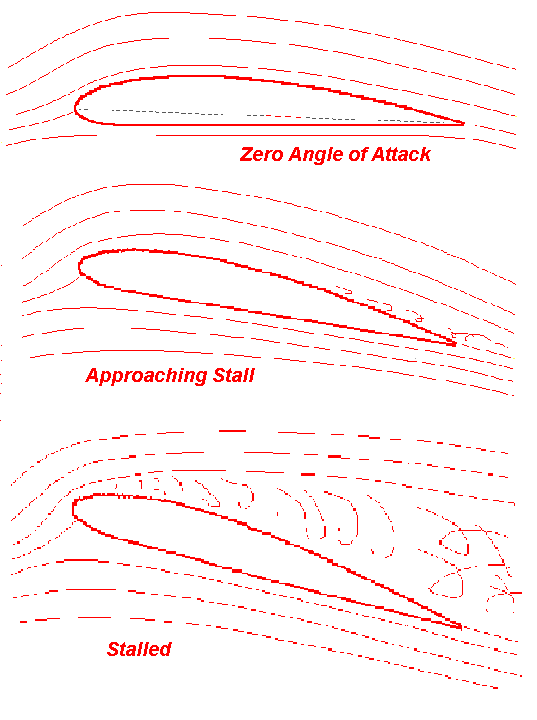
THE STALL And Angle of Attack
Stall, spin, crash!
All too often thats how our lovingly crafted aircraft die. Our aircraft all have to be operated with certain limits - the flying ``envelope'' of any particular aircraft design. A machine can only structurally stand so hard a landing, only so many Gs loading, and go no more than a certain speed before coming apart. And aerodynamically, the plane can only go so slow and stay airborne; ...and this is the limit that seems to cause us the most difficulty.
Actually, strictly speaking, a stall is NOT directly tied to airspeed. Loosely defined, a stall occurs when the angle of attack of the planes wing exceeds the point where the airflow can follow the wings contour; the organized airflow breaks down, sharply reducing lift (see diagram). Essentially, airflow just can't ``hack the turn'' at the leading edge of the wing. As long as we don't yank back on the stick, forcing a stalling angle of attack, we can still ``fly'' VERY slowly without stalling - over the top of a loop, for instance. And we all know that a plane can also be stalled at very high speeds - any snap maneuver involves a stall.
But folks will advertise the stalling SPEED of an aircraft; when they do so, certain conditions must be specified or implied: 1) straight and level flight 2) the weight of the plane (``at max gross'') 3) Atmospheric conditions (``sea level, standard day'') 4) power on or off 5) high lift devices (flaps up or down). -All these conditions affect the actual airspeed at which the plane will reach the stalling angle of attack.
Now, getting to the plane itself, what determines the stalling angle of attack? Mostly, the type of airfoil used on the wing, and the shape (planform) of the wing.

To recap these points: Once your plane is built, the wing shape and airfoil determine the stalling angle of attack; this is pretty much FIXED. The conditions you are flying with, and how you fly the plane, determine the SPEED at which a stall will occur.
Let's take an example; the Nifty Fifty, a .40-.50 size trainer. With 500 square inches of wing, an N-60 airfoil, and an aspect ratio of 6, at 5 pounds this plane will stall at about 20 mph. Adding a 3 pound brick to the plane, the stall speed goes up to 26 mph. That may not seem too bad, but if we were landing in a 14 mph wind, the ground speed (the speed we SEE) is DOUBLED with the brick!! But in BOTH cases, the stall angle of attack is the same, at 10 degrees. Back at 5 pounds again, we enter a steady 60 degree bank turn; the stall speed in this case will be 30 mph, but STILL 10 degrees angle of attack. And if we were to pull 5 ``Gs'' coming out of a loop, the stall speed would be 46 mph!! Note that all these figures would be a bit higher at high altitude, or on a very hot day. Also, be aware that a plane stalls at a bit higher speed with power off than power on.
It follows, then, that to avoid stalling your plane, don't pay so much attention to the SPEED of the plane - its hard to judge anyway - keep your eye on the ATTITUDE of the plane with respect to its flight path. That attitude (how high the nose is) will tell you whether or not you're close to the stall, pretty much regardless of any other conditions, other than flaps or other moveable high lift devices.
Let's look at one other item - stick travel. For most fairly stable aircraft, the amount you move the stick (and thus the elevator) determines the angle of attack the plane flies at. If you can get a violent stall with less than full back stick, you may want to consider using less elevator travel. Most trainer plans give you an elevator throw figure that doesn't ALLOW a stall in any normal flight situation - this is also worthy of consideration, depending on your skill level and what you want your plane to do.
Above all, spend some time flying your plane close to, and into the stall. Most planes, other than pattern and racing craft, recover from a stall very nicely with some power and easing the back stick. Get used to the signs of impending stall; get used to recovery. Get used to the ATTITUDE at which this all occurs. Exploring the low-speed area of your planes performance characteristics will make you a far better, safer pilot! ...Clay
Site maintained by QSoftWorks
Last Update: 10/12/97